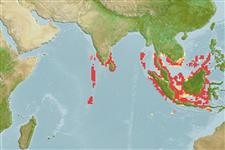>
Eupercaria/misc (Various families in series Eupercaria) >
Nemipteridae (Threadfin breams, Whiptail breams)
Etymology: Scolopsis: Name from the Greek masculine noun 'skolos' meaning 'thorn' and suffix '-opsis' (from Greek feminine n. 'opsis' meaning 'aspect', 'appearance') meaning ‘thorny appearance’ presumably referring to 'les dentelures de la préopercule, en ont aussi, et même d'épineuses, aux sous-orbitaires' mentioned by Cuvier (1814) in his designation of the genus. Name ending in -'opsis' are treated as feminine according to ICZN 1999: Article 30.1.2 (Ref. 130620).
Environment: milieu / climate zone / depth range / distribution range
Ecologia
marinhas associadas(os) a recifes; intervalo de profundidade 1 - 30 m (Ref. 48635). Tropical; 13°N - 12°S, 67°E - 120°E (Ref. 3810)
Indian Ocean: Maldives, Sri Lanka and southern Indonesia. This species has been reported by most authors under the name Scolopsis personatus, but Scolopsis auratus is the older name.
Tamanho / Peso / Idade
Maturity: Lm ? range ? - ? cm
Max length : 26.0 cm TL macho/indeterminado; (Ref. 90102); common length : 18.0 cm SL macho/indeterminado; (Ref. 3810)
Espinhos dorsais (total) : 10; Raios dorsais (total) : 9; Espinhos anais: 3; Raios anais : 7. Lower limb of preopercle scaly. Antrorse (forward-directed) suborbital spine absent. Pelvic fins long, reaching to or just beyond level of anus. Axillary scale present. Color: Body silvery-white and dusky blue on back. Snout dusky. A narrow pale bluish stripe joining eyes behind nostrils.
Occurs close to reefs (Ref. 9785). Adults at moderate depths in small, loose groups. Juveniles solitary and in sheltered bays along reef edges with rubble or coarse sand (Ref. 48635).
Ciclo de vida ou comportamento de acasalamento
Maturities | Reprodução | Spawnings | Egg(s) | Fecundities | Larvas
Russell, B.C., 1990. FAO Species Catalogue. Vol. 12. Nemipterid fishes of the world. (Threadfin breams, whiptail breams, monocle breams, dwarf monocle breams, and coral breams). Family Nemipteridae. An annotated and illustrated catalogue of nemipterid species known to date. FAO Fish. Synop. 125(12):149p. Rome: FAO. (Ref. 3810)
Status na Lista Vermelha da UICN (Ref. 130435)
Ameaça para os humanos
Harmless
Uso pelos humanos
Pescarias: pesca de subsistência
Ferramentas
Relatórios especiais
Baixar XML
Fontes da internet
Estimates based on models
Preferred temperature (Ref.
123201): 28.3 - 29.3, mean 28.9 °C (based on 827 cells).
Índice de diversidade filogenética (Ref.
82804): PD
50 = 0.5000 [Uniqueness, from 0.5 = low to 2.0 = high].
Bayesian length-weight: a=0.01622 (0.00730 - 0.03605), b=2.98 (2.80 - 3.16), in cm total length, based on LWR estimates for this Genus-body shape (Ref.
93245).
Nível Trófico (Ref.
69278): 3.7 ±0.5 se; based on size and trophs of closest relatives
Resiliência (Ref.
120179): Elevada, tempo mínimo de duplicação da população menor que 15 meses (Preliminary K or Fecundity.).
Fishing Vulnerability (Ref.
59153): Low vulnerability (16 of 100).
Nutrients (Ref.
124155): Calcium = 62.2 [38.7, 126.7] mg/100g; Iron = 0.679 [0.334, 1.628] mg/100g; Protein = 19 [17, 21] %; Omega3 = 0.146 [0.089, 0.241] g/100g; Selenium = 27.1 [16.1, 49.0] μg/100g; VitaminA = 76.6 [21.5, 222.5] μg/100g; Zinc = 1.32 [0.91, 1.91] mg/100g (wet weight);
